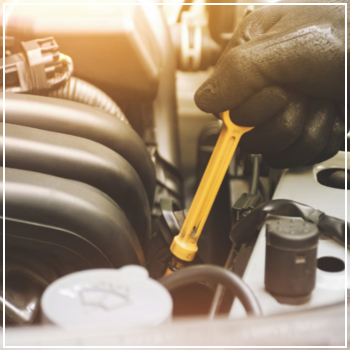Understanding the Fluids Your Car Needs
 Regular maintenance is essential for keeping your car running smoothly. Checking fluids like engine oil, coolant, and brake fluid can prevent major issues down the road. Skipping oil changes or using low-quality fluids can lead to poor performance, reduced fuel efficiency, and even costly repairs.
Regular maintenance is essential for keeping your car running smoothly. Checking fluids like engine oil, coolant, and brake fluid can prevent major issues down the road. Skipping oil changes or using low-quality fluids can lead to poor performance, reduced fuel efficiency, and even costly repairs.
Did you know that around 25% of vehicles on the road have at least one fluid that’s low or needs replacing? Understanding what each fluid does and how to check it can help you stay ahead of potential problems. Here's a breakdown of the most important fluids in your vehicle and how to maintain them.
Engine Oil
Engine oil is the lifeblood of your car's engine. It reduces friction between moving parts, prevents overheating, and keeps the engine clean by carrying away debris. Without enough oil, your engine could suffer serious damage.
It’s recommended to change your oil every 3,000 to 5,000 miles, depending on your vehicle and driving conditions. To check it yourself, park on a flat surface and let the engine cool. Locate the dipstick, pull it out, wipe it clean, and reinsert it before checking the level again. The oil should be between the “full†and “add†marks. Also, pay attention to the color—fresh oil is golden, while dark or sludgy oil may need changing.
Transmission Fluid
Transmission fluid helps your car shift gears smoothly and keeps the transmission system lubricated. Low or dirty fluid can cause jerking, delayed shifting, or even complete failure.
Most modern cars don’t require frequent transmission fluid changes, often going 60,000 to 100,000 miles between services. However, it’s still a good idea to check the level and condition regularly. New fluid is typically red and clear, while older fluid may look brown or have particles in it.
Coolant (Antifreeze)
Coolant regulates your engine’s temperature, preventing it from overheating in hot weather and freezing in cold climates. It also protects against rust and corrosion inside the cooling system.
Check your coolant level every 50,000 miles or as needed. If it looks cloudy, dark, or has a strange odor, it might be time for a flush. Never replace coolant with water—it can cause long-term damage to your engine.
Brake Fluid
Brake fluid is crucial for your car’s braking system. It transfers pressure from the brake pedal to the calipers, helping slow or stop your vehicle. Low or contaminated brake fluid can lead to unsafe braking performance.
Brake fluid should be changed every 2–3 years or as recommended by your manufacturer. It’s best left to professionals, as moisture and dirt can easily contaminate the system if not handled properly.
Power Steering Fluid
Power steering fluid makes it easier to turn the steering wheel. If the fluid is low, steering becomes stiff and harder to control.
Check the fluid level regularly, especially if you notice any unusual noises when turning. Most vehicles have a reservoir that you can top off easily at home.
Windshield Washer Fluid
Windshield washer fluid ensures your wipers work effectively, keeping your windshield clear. If you drive in dusty or rainy conditions, you’ll need to refill this more often.
This is a simple task you can do at home. Just locate the reservoir under the hood and fill it with the appropriate fluid, making sure not to overfill.
Other Important Fluids
In addition to the above, your car uses several other fluids, including:
- Differential Fluid: Lubricates the gears in your rear and front axles, helping with power transfer and handling.
- Refrigerant: Keeps your air conditioning system running efficiently, providing cool air during hot weather.
Ignoring regular checks on these fluids can lead to expensive repairs, decreased performance, and even safety risks. Make sure to schedule routine maintenance and never skip a fluid check. If you’re unsure about anything, always consult a professional mechanic.
Printech printed prepainted steel is a type of steel that has been coated with a special type of paint that allows high-quality printing to be applied onto the surface of the steel. The surface of the steel is first cleaned and treated with a primer to ensure that the paint will adhere properly. Then, a special ink is applied to the surface of the steel using a printing process, which can create a wide range of colors, patterns, and designs.
Printech printed prepainted steel is commonly used in a variety of applications, such as building facades, signage, and interior design. The ability to print high-quality graphics and designs directly onto the steel surface allows for highly customized and eye-catching designs. This makes it a popular choice for commercial and industrial buildings, as well as for high-end architectural and interior design projects.
One advantage of Printech printed prepainted steel is its durability. The paint used in the printing process is typically a type of polyester or polyvinylidene fluoride (PVDF) paint, which is resistant to fading, chalking, and peeling. This makes it ideal for outdoor applications and areas with high humidity or exposure to harsh weather conditions.
Another advantage of Printech printed prepainted steel is its versatility. The printing process can create a wide range of colors, patterns, and designs, allowing for highly customized and unique finishes. This makes it an ideal material for a variety of applications, such as building facades, signage, and interior design.
Printech Printed Steel,Wooden Pattern Preprinted Steel,Wood Grain Pre-Printed Steel Coil,Stone Grain Printed Color Steel Coils
Wuxi Shengshu Metal Co., Ltd. , https://www.wuxissmetal.com